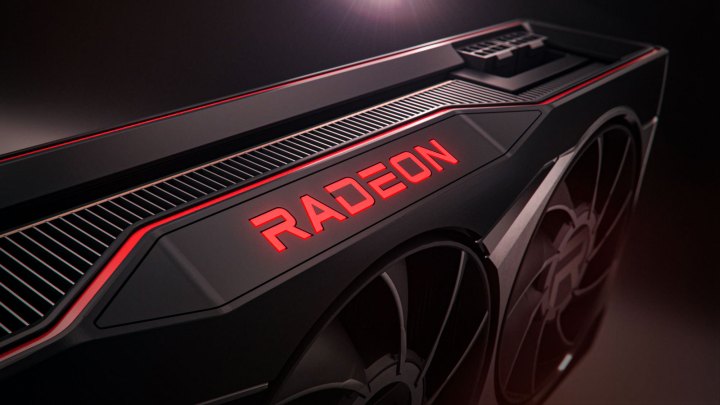As we approach the arrival of Nvidia and AMD’s next-gen graphics cards, more details about the GPUs, particularly in the case of the latter, have begun to emerge.
Moore’s Law Is Dead’s latest video provided a deeper look at AMD’s Navi 33 GPU, which is powered by the RDNA 3 architecture and is said to be the silicon that Team Red’s next-gen entry-level and midrange video cards will utilize.

According to the leaker’s most trusted sources, Navi 33 is indeed a monolithic 6nm die “designed to bring Navi 21 performance to midrange die sizes.” Another interesting tidbit from the leak indicates that Navi 33 “utilizes faster GDDR6 over a smaller than Navi 21 bus, strips out a few high-end features to reduce die size, and leverages the RDNA 3 architecture for lower power at high clocks.”
The sources said that 18Gbps GDDR6 memory is expected to be categorized as “low end” by the end of 2022, and they believe 20Gbps will become the new standard for midrange memory, while 22 to 24Gbps is reserved for high-end premium cards. We’ve already heard that certain flagship Nvidia Ada RTX 40-series GPUs will feature around 24Gbps of memory, which Moore’s Law Is Dead expects to be the case for the top RDNA 3 cards as well.
As reported by NotebookCheck, Moore’s Law Is Dead also believes Navi 33 will come with 128MB of Infinity Cache. He adds that there is a “slim chance” that the Infinity Cache amount could theoretically reach 256MB, but he expects the former amount to be retained in order to “support Navi 21-like performance.”
One of the areas where AMD is reportedly cutting back on is the bus size, which is expected to be reduced to a 128-bit bus, joined by 8GB of GDDR6 memory. However, Moore’s Law Is Dead stresses that Navi 33 will deliver considerably faster RAM speeds (within the 20Gbps range) compared to the current-gen RDNA 2 architecture.
“Limiting Navi 33 to 8GB was an intentional design decision. This is firmly a midrange or even lower midrange card.”
The above technical specifications, therefore “should” offer an upgrade in rasterization performance when compared to the current-gen premium RX 6900XT graphics card. As a result, Navi 33 entry-level GPUs will apparently offer superior 1080p performance, as well as “trading blows” in 1440p. One area it may fall short is 4K, but Moore’s Law Is Dead emphasizes the fact that Navi 33 is predominantly geared toward 1440p gaming.
Elsewhere, Moore’s Law Is Dead believes ray tracing will be significantly upgraded, stressing that the jump will represent a “much larger increase” compared to the rasterization improvements.
The power consumption level for Navi 33, meanwhile, was originally expected to hit the 200-watt mark. However, as the card is “about to become the new midrange, or maybe even the new lower midrange” GPU that “will compete with the last-gen flagships” with a lower power draw, that figure has been revised to be between the 180- and 230-watt range.
Rounding out the rumored specifications of Navi 33 is its PCIE 5.0 lanes count, which “most sources” believe to be eight lanes.

RDNA 3 vs Nvidia Ada
As for the price of Navi 33 boards, Moore’s Law Is Dead believes the manufacturer’s suggested retail price (MSRP) is between $399 to $499. If all the aforementioned technical specifications come to fruition, that price tag will make RDNA 3 graphics cards an extremely attractive option for the entry/midrange market. For reference, the RDNA 2-based Radeon RX 6900XT retails for $999, meaning Navi 33 boards could very well offer similar performance at half the cost.
As a YouTube comment aptly highlights, “considering so many people are moving to 1440p gaming, a 6900XT level card at lower midlevel prices is smart. And if they can pump out enough inventory, they will sell as fast as they can make them.”
And that’s what many expect to be the focal point of the battle of next-gen between Nvidia and AMD: If there are enough stock levels to satisfy demand. After all, the generational upgrade we are hearing about in regard to RDNA 3 and Nvidia Ada is shaping up to be one for the ages, so there will be a considerable amount of interest surrounding these next-gen GPUs.
Efficiency is another area that has been a major talking point pertaining to next-gen AMD and Nvidia graphics cards. The previous Moore’s Law Is Dead leak already suggested that Nvidia is facing a “real, true efficiency problem coming up.” Lending credence to that claim is multiple AMD engineers seemingly stating that “they are 100% confident RDNA 3 will decimate Nvidia in efficiency across the entire lineup.”
Moore’s Law Is Dead also teased a future video by showing a teaser of a concept render for an upcoming RX 7000 graphics card. In particular, he says we’ll get a closer look at the products that use more advanced packaging techniques, which he’s “100% sure of the crazy stuff AMD’s about to do in upcoming architectures.”




